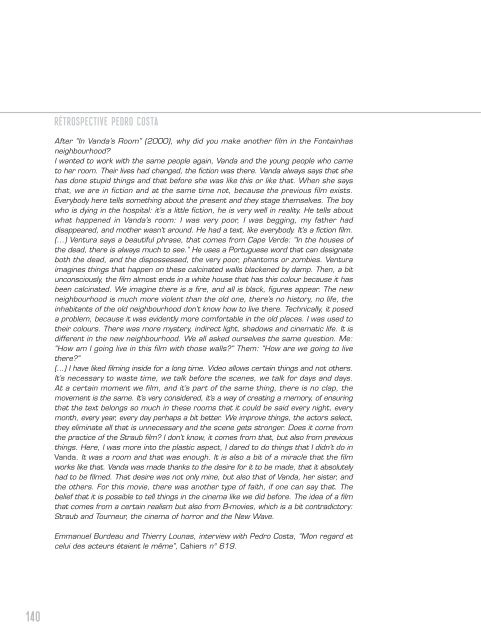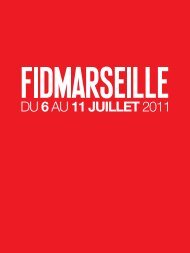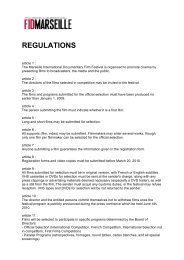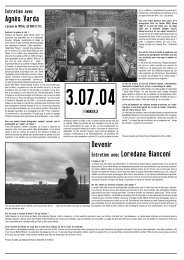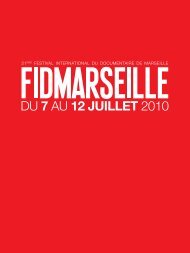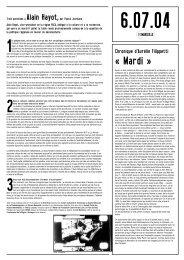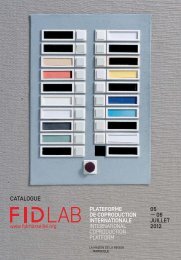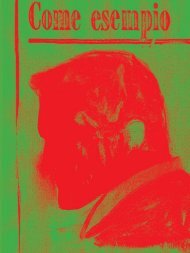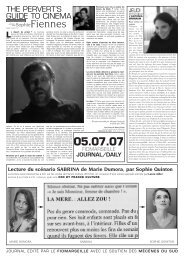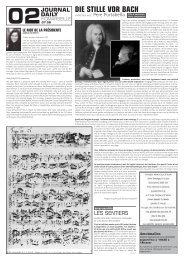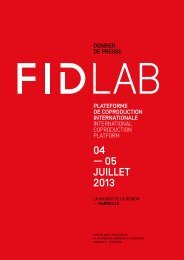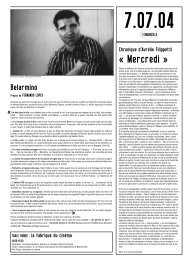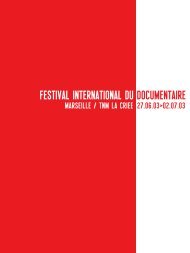catalogue 2007 en .pdf - Festival international du documentaire de ...
catalogue 2007 en .pdf - Festival international du documentaire de ...
catalogue 2007 en .pdf - Festival international du documentaire de ...
You also want an ePaper? Increase the reach of your titles
YUMPU automatically turns print PDFs into web optimized ePapers that Google loves.
MICHEL TREGANRÉTROSPECTIVE PEDRO COSTAAfter “In Vanda’s Room” (2000), why did you make another film in the Fontainhasneighbourhood?I wanted to work with the same people again, Vanda and the young people who cameto her room. Their lives had changed, the fiction was there. Vanda always says that shehas done stupid things and that before she was like this or like that. Wh<strong>en</strong> she saysthat, we are in fiction and at the same time not, because the previous film exists.Everybody here tells something about the pres<strong>en</strong>t and they stage themselves. The boywho is dying in the hospital: it’s a little fiction, he is very well in reality. He tells aboutwhat happ<strong>en</strong>ed in Vanda’s room: I was very poor, I was begging, my father haddisappeared, and mother wasn’t around. He had a text, like everybody. It’s a fiction film.(...) V<strong>en</strong>tura says a beautiful phrase, that comes from Cape Ver<strong>de</strong>: “In the houses ofthe <strong>de</strong>ad, there is always much to see.” He uses a Portuguese word that can <strong>de</strong>signateboth the <strong>de</strong>ad, and the dispossessed, the very poor, phantoms or zombies. V<strong>en</strong>turaimagines things that happ<strong>en</strong> on these calcinated walls black<strong>en</strong>ed by damp. Th<strong>en</strong>, a bitunconsciously, the film almost <strong>en</strong>ds in a white house that has this colour because it hasbe<strong>en</strong> calcinated. We imagine there is a fire, and all is black, figures appear. The newneighbourhood is much more viol<strong>en</strong>t than the old one, there’s no history, no life, theinhabitants of the old neighbourhood don’t know how to live there. Technically, it poseda problem, because it was evid<strong>en</strong>tly more comfortable in the old places. I was used totheir colours. There was more mystery, indirect light, shadows and cinematic life. It isdiffer<strong>en</strong>t in the new neighbourhood. We all asked ourselves the same question. Me:“How am I going live in this film with those walls?” Them: “How are we going to livethere?”(...) I have liked filming insi<strong>de</strong> for a long time. Vi<strong>de</strong>o allows certain things and not others.It’s necessary to waste time, we talk before the sc<strong>en</strong>es, we talk for days and days.At a certain mom<strong>en</strong>t we film, and it’s part of the same thing, there is no clap, themovem<strong>en</strong>t is the same. It’s very consi<strong>de</strong>red, it’s a way of creating a memory, of <strong>en</strong>suringthat the text belongs so much in these rooms that it could be said every night, everymonth, every year, every day perhaps a bit better. We improve things, the actors select,they eliminate all that is unnecessary and the sc<strong>en</strong>e gets stronger. Does it come fromthe practice of the Straub film? I don’t know, it comes from that, but also from previousthings. Here, I was more into the plastic aspect, I dared to do things that I didn’t do inVanda. It was a room and that was <strong>en</strong>ough. It is also a bit of a miracle that the filmworks like that. Vanda was ma<strong>de</strong> thanks to the <strong>de</strong>sire for it to be ma<strong>de</strong>, that it absolutelyhad to be filmed. That <strong>de</strong>sire was not only mine, but also that of Vanda, her sister, andthe others. For this movie, there was another type of faith, if one can say that. Thebelief that it is possible to tell things in the cinema like we did before. The i<strong>de</strong>a of a filmthat comes from a certain realism but also from B-movies, which is a bit contradictory:Straub and Tourneur, the cinema of horror and the New Wave.Emmanuel Bur<strong>de</strong>au and Thierry Lounas, interview with Pedro Costa, “Mon regard etcelui <strong>de</strong>s acteurs étai<strong>en</strong>t le même”, Cahiers n° 619.140


